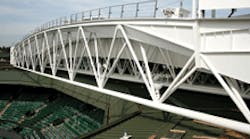All England Lawn Tennis and Croquet Club, www.wimbledon.org Edge Structures Ltd., www.edgestructures.com Galiford Try, www.gallifordtry.co.uk Moog Industrial Group, www.moog.com |
When the Wimbledon Championships kick off later this month on the grass courts at the All England Lawn Tennis and Croquet Club, players won’t have to worry about being rained out. In 2004, All England entertained proposals for a retractable roof operated by hydraulic cylinders.
But the design of Centre Court proved problematic for a hydraulic installation. For one thing, hydraulics eventually leak. Hydraulic fluid would inevitably drip onto the field, a bad idea on numerous levels. All England brought the design problems to Simon Furnell at Moog, East Aurora, N.Y. Moog suggested replacing the hydraulic systems in favor of a totally electric installation.
Wimbledon’s retractable roof now consists of two sections opening north and south. A total of 10 trusses in the two sections span 77 m (253 ft) over Centre Court and support 5,200 m2 (56,000 ft2) of fabric. A wheeled carriage or “bogie” at each end of the 110-tonne (121-ton) trusses rolls along two sets of parallel rails to move the roof section. Overall, 40 bogie motors, two on each of the wheeled carriages, position the roof trusses.
Roof trusses had to remain tightly aligned as they moved. Specifications demanded that there be no misalignment from side to side exceeding 25 mm (1 in.). The synchronized Moog motors hold misalignment to less than 2 mm (0.09 in.) across the 77-m (253-ft) span while in motion, and position to within 0.1 mm at rest.
Besides the bogie motors, each section holds four restraint arms controlled by electric actuators. These provide rigidity to the roof structure when deployed.
End-arm electric actuators provide the main force to move the V-shaped roof sections and fabric into position as the roof closes to help reduce top loading on the trusses. Each of the four actuators can provide 35 metric tonnes (38.6 U.S. tons) of force and are synchronized such that they share the load equally.
Overall, the retractable roof has 148 axes of control using 20 real-time Moog servo controllers and 20 PLCs housed in 40 control cabinets.
It would seem that such a complex system would need an equally complex control panel. But the process of opening and closing the roof had to be as simple as possible. So the control panel consists of just a few buttons. These control actions such as Move to Park, Move to Championship, Sunshade, Open, Close, and Emergency stop. Under normal operation, the roof would be in one of three main positions: Park, Championship, or Closed. The roof spends most of its time in Park. The Park position moves all 10 trusses to the north end of the field to bathe the court in sunlight. If the roof stayed in place, the south side of the court wouldn’t get enough sunlight to germinate grass seed.
“Move to Championship” sends the five southern trusses to the south side of the court before play begins, where they stay if it remains sunny. Should rain threaten play, the roof closes tight in slightly over 8 min with all actuators and motors working in synchronization after a push of the “Close” button. Closing the roof also activates a sophisticated high-capacity air-handling system that maintains proper playing conditions at Centre Court. From roof closure to resumption of play takes about 20 min. When the rain ends, the “Open” button brings everything back to the Championship position.
A digital encoder along the entire length of rail has 0.1-mm (0.004 in.) accuracy and resolution to a micron. A traffic-light system lets operators monitor roof operations as the trusses move. Green indicates all is well, while two ambers indicate possible problems without the need to stop motion. Red, of course, indicates a definite problem, and all movement stops. During a test, a simple flat washer was left on one of the tracks. The system detected the washer and dropped to the second amber condition, slowed and rolled over the washer, and then moved on.
Copyright 2010, Penton Media Inc. All rights reserved.
